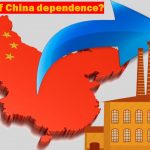India – Hot Destination after China
In our last blog ‘Endgame of China dependence?’, we looked at how countries and companies around the world are too reliant on China and how some of them have already started diversifying their supply chains. In case, you haven’t checked out that blog, you can read it here.
No more ‘all eggs in one basket’..
 Manufacturers and suppliers have been leaving or wanting to leave China for a multitude of reasons including the US-China trade war as well as the increasing cost of labour. The effect of the coronavirus pandemic has further highlighted the dependency of countries on China and provided a boost to this exodus. Businesses have now realized that it does not make sense limiting their supply chain dependency to China alone. In a post COVID-19 scenario, countries which have huge dependency on China, like the United States, Japan, and South Korea are looking at other options, especially in low-cost Asian countries. In this blog, we will take a look at why India is becoming an attractive destination for manufacturers and suppliers to move to after the COVID-19 crisis.
Manufacturers and suppliers have been leaving or wanting to leave China for a multitude of reasons including the US-China trade war as well as the increasing cost of labour. The effect of the coronavirus pandemic has further highlighted the dependency of countries on China and provided a boost to this exodus. Businesses have now realized that it does not make sense limiting their supply chain dependency to China alone. In a post COVID-19 scenario, countries which have huge dependency on China, like the United States, Japan, and South Korea are looking at other options, especially in low-cost Asian countries. In this blog, we will take a look at why India is becoming an attractive destination for manufacturers and suppliers to move to after the COVID-19 crisis.
The companies that have moved or are planning to move India include Foxconn, Wistron, Hasbro, Samsung and Apple. Foxconn is shifting the mass production of iPhones from China to India as according to them, the labour cost in India is three times lower compared to that in China. Samsung closed its last mobile phone factory in China, as a result of the rising labour costs and economic slowdown. It started production of mobiles in India and aims to double the capacity from 68 million units a year to 120 million units a year by FY2020. Apple has previously produced low-cost iPhone models in India. In 2019, it was reportedly considering shifting production of its more premium models to India so as to avoid tariffs on imported smartphones from China.
India – A Go-To place for the world
According to the United Nations Conference on Trade and Development (UNCTAD), India was among the top 10 recipients of Foreign Direct Investment (FDI) in 2019. Driving the FDI growth in South Asia, India attracted $49 billion in inflows. This meant an increase of 16% from 2018. According to FDI statistics published by the Department for Promotion of Industry and Internal Trade (DPIIT), the top 10 countries investing in India, as of December 2019, are Mauritius, Singapore, Japan, Netherlands, USA, UK, Germany, Cyprus, France and UAE.
 According to UBS, India continues to be among the top destinations in Asia for manufacturing shift and that trade data confirms market share gains for India in exports to the US, for tariff-imposed products. Further, UBS also mentions that researchers analysed earnings transcripts of 44 global companies to spot nuances in language that might signify a potential relocation of manufacturing to India. Increased references to ‘India’ and ‘trade war’ were found.
According to UBS, India continues to be among the top destinations in Asia for manufacturing shift and that trade data confirms market share gains for India in exports to the US, for tariff-imposed products. Further, UBS also mentions that researchers analysed earnings transcripts of 44 global companies to spot nuances in language that might signify a potential relocation of manufacturing to India. Increased references to ‘India’ and ‘trade war’ were found.
The lure of India is strong… and with good reason!
There is no one reason as such, but a multitude of good reasons that make India an appealing destination. India, the largest democracy in the world, has a stable government which ensures a calm and conducive environment. One of the world’s fastest growing economies, India is a land of unlimited opportunities. According to EY Emerging Markets Centre, India was ranked as the most attractive market by leading investors. India is all set to have the world’s largest youth population by the year 2020, as per the UN Population Fund. According to the British Council, India is set to be the largest supplier of university graduates in the world by 2020. It is therefore doubtless that India possesses an educated, hard-working and skilled work force. The Press Information Bureau of the Government of India states that over the next 20 years, more than $1.5 trillion investments have been planned for infrastructure, across key sectors such as Railways, Ports, Airports, Industrial Corridor and Smart Cities.
 India’s economic influence is on the rise. India and China are touted to be the largest manufacturing hubs of the world by the end of the current decade, according to Lloyd’s Register of Marine & University of Strathclyde, Glasgow. With the companies looking to move out of China, India is very likely to be the next preferred destination. India has a huge domestic market. According to McKinsey Global Institute, India’s private consumption is set to increase four times as much by 2025, thus making it one of the world’s largest markets for manufactured goods and services. In the five-year period between 2014 and 2019, India has leapt 79 positions to 63rd in the World Bank’s Ease of Doing Business rankings for 2020. To add to that, the Indian government has taken several reformative actions to attract foreign investment such as reducing corporate tax to 25.27 percent and further slashing it down to 17 percent for new manufacturers which is the lowest in South East Asia. With the reduced tax rate and the implementation of a single tax structure in the form of GST, it paves the way for a common national market by integrating various indirect taxes.
India’s economic influence is on the rise. India and China are touted to be the largest manufacturing hubs of the world by the end of the current decade, according to Lloyd’s Register of Marine & University of Strathclyde, Glasgow. With the companies looking to move out of China, India is very likely to be the next preferred destination. India has a huge domestic market. According to McKinsey Global Institute, India’s private consumption is set to increase four times as much by 2025, thus making it one of the world’s largest markets for manufactured goods and services. In the five-year period between 2014 and 2019, India has leapt 79 positions to 63rd in the World Bank’s Ease of Doing Business rankings for 2020. To add to that, the Indian government has taken several reformative actions to attract foreign investment such as reducing corporate tax to 25.27 percent and further slashing it down to 17 percent for new manufacturers which is the lowest in South East Asia. With the reduced tax rate and the implementation of a single tax structure in the form of GST, it paves the way for a common national market by integrating various indirect taxes.
 According to Santander Trade, India’s well-developed administration and an independent judicial system, coupled with the vast geography and a wealth of natural resources make it an attractive destination for businesses. India’s proximity to key manufacturing sites, key suppliers and low development costs mean that India is an effective base from which MNCs can export to other emerging markets. Indian companies were given top ranking among emerging market MNCs in terms of transparency and compliance by Transparency International.
According to Santander Trade, India’s well-developed administration and an independent judicial system, coupled with the vast geography and a wealth of natural resources make it an attractive destination for businesses. India’s proximity to key manufacturing sites, key suppliers and low development costs mean that India is an effective base from which MNCs can export to other emerging markets. Indian companies were given top ranking among emerging market MNCs in terms of transparency and compliance by Transparency International.
To sum up, India, with its economic influence, young and energetic work force as well as wealth of resources shall remain a hot destination for global manufacturers and suppliers to invest in, especially after the COVID-19 crisis.
Your comments and feedback are much appreciated!




